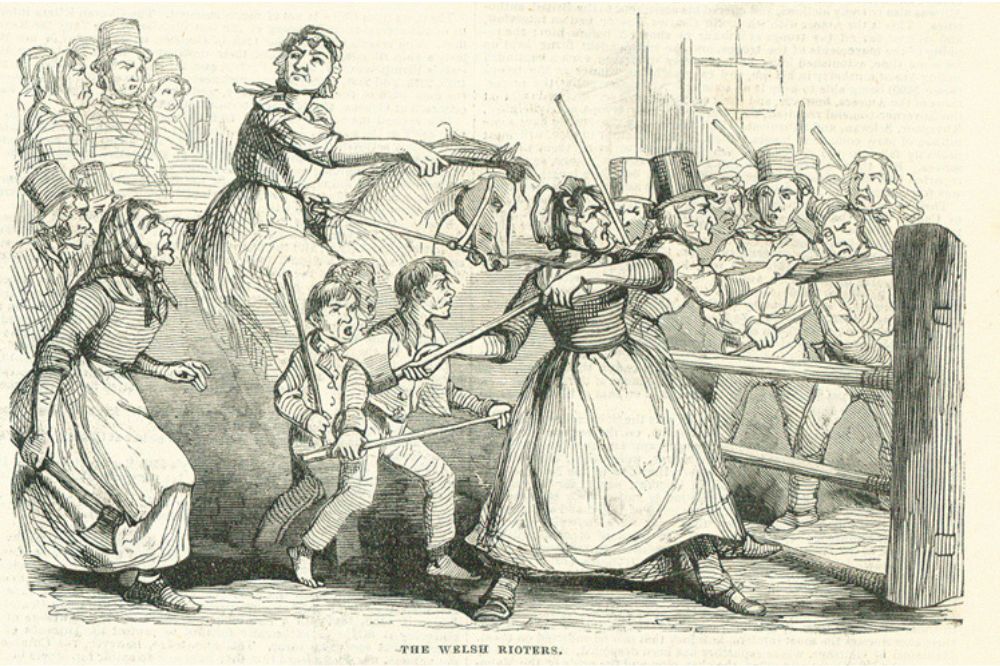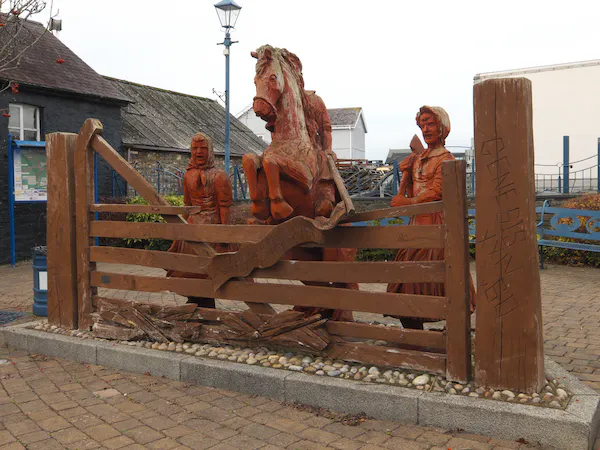Why men in 19th century Wales dressed as women to protest taxation

Senior Lecturer in Modern History, Bangor University
South-west Wales was reeling in the wake of social unrest in November 1843. There had been a series of protests over several years by farmers furious at taxation levels, mainly attacking tollgates. Often, the men involved dressed as women and were therefore known in Welsh as Merched Beca (Rebecca’s daughters). The events that unfolded came to be known as the Rebecca riots in English.
There has been speculation that the name “Rebecca” stemmed from a literal interpretation of Genesis 24:60 in the Bible, which refers to Rebekah’s offspring possessing the gates of their enemies. But the truth is, nobody really knows why the name was chosen.
Tollgates had been introduced in Britain from the late 17th century as a means of raising revenue to maintain public roads. They were regulated and maintained by the Turnpike Trusts, individual bodies set up by parliament.
Tolls had long been regarded as a burden by the people. But complaints to magistrates about their unfair regulation were largely ignored. The tollgates therefore became regarded as symbols of oppression to be demolished by the Rebeccaites, with unrest largely concentrated across Carmarthenshire, Cardiganshire and Pembrokeshire.
The first recorded appearance of Rebecca was on May 13 1839, when a tollgate at Efailwen in Pembrokeshire was demolished. Rebecca emerged again during the winter of 1842, with protests intensifying throughout the summer of 1843.
The attacks targeted tollgates and private property, while toll-keepers and authority figures were also intimidated. These included the local gentry, who upheld law and order locally as magistrates and oversaw the administration of the tolls as members of the Turnpike Trusts.
Those who protested were predominantly young men who were tenant farmers, farm servants and agricultural labourers. But other protesters included non-agricultural labourers from industrialised regions of Carmarthenshire and neighbouring Glamorgan.
A striking element of the protest was the adoption of women’s clothing to conceal the identities of those involved. This was theatrically woven into the ritual of protest as “Rebecca”, the name given to the leader of the various protests, called on her children to tear down any gate that blocked their way.
However, the Rebecca riots were more than just a protest movement against the tolls. They were also a reaction to the socio-economic climate, to agricultural depression, failing harvests, rising levels of rent and the weight of various taxes. All these factors collectively placed substantial pressure on rural communities.
There was also widespread criticism of the administration of the new Poor Law, introduced in 1834, which ensured that poor people were housed in workhouses, where families were separated, subjected to hard work and harsh living conditions.
Escalation
On June 19 1843, a procession in the market town of Carmarthen led to the storming of the workhouse. This signalled a turning point that saw the protests intensify, with attacks on private property in addition to tollgates.

Firearms
There were reports of physical violence and use of firearms too, with one recorded death, that of Sarah Williams, the 75-year-old keeper of the Hendy tollgate in Carmarthenshire. Someone shot her while she tried to rescue her belongings from the burning tollhouse on September 9 1843.
Following the Carmarthen workhouse attack, The Times newspaper sent Thomas Campbell Foster to report on “The State of South Wales”. His reports disseminated news of Rebecca and her daughters across Britain.
Even Queen Victoria was concerned by the events. She wrote in her journal how she strongly advised the home secretary, Sir James Graham, to apprehend and punish the Rebeccaites. She feared events in Wales would spur on the movement in Ireland to repeal the laws which tied Ireland to Great Britain.
Into the autumn and winter months of 1843, Rebecca and her daughters appeared less frequently. Although a Carmarthenshire land agent, Thomas Herbert Cooke, wrote in late November how “an incendiary fire however occurs now and then to let people know that Rebecca is still alive, and sometimes awakes from her slumbers”.
Government Inquiry
During this time, a government inquiry was conducted into the causes of the riots, reporting its findings in the spring of 1844. Although the tollgates survived, the findings of the inquiry led to greater regulation of the Turnpike Trusts in Wales. New county police forces were also established in the wake of the riots.
In total, around 250 tollhouses and gatehouses were destroyed by Rebecca. In the aftermath, those captured and accused were punished by transportation to the penal colonies in Tasmania. Those such as John Hughes, known as Jac Tŷ Isha, were never to return to their native Wales. Others took on an almost mythical identity among local people, such as Thomas Rees, or Twm Carnabwth, remembered as the leader of the first Rebecca attack at Efailwen.
However, Rebecca did not disappear entirely, and instances of protest and threatening letters sent in her name appear later in other parts of Wales. During the 1870s, Rebecca and her daughters appeared in protests concerning salmon poaching on the river Wye in mid Wales, described as the “second Rebecca Riots”.
In the 20th century, the concept of Rebecca was invoked once more. In 1956, Welsh language newspaper, Y Seren, inferred that “the spirit of Beca” was once again needed to campaign against the flooding of Cwm Tryweryn in Gwynedd to create a reservoirto provide drinking water for Liverpool.
And Rebecca continues to resonate in Wales to this day, inspiring re-enactments and community engagement – it shows that the fight for justice and the tradition of protest continues to play a powerful part in Welsh society.
This article was first published on The Conversation
![]()
Support our Nation today
For the price of a cup of coffee a month you can help us create an independent, not-for-profit, national news service for the people of Wales, by the people of Wales.







Were they trying to “erase women” perhaps? To win at women’s sports? To “ram something or other” down “normal” people’s throats? Apparently that’s a thing, although I have never seen it. There was no point trying to disguise themselves as women though because apparently “we can always tell”. I wonder if this is why the Tory government is going so hard after the the trans folks right now. They are afraid that protestors will re-enact the Rebecca riots in protest of their many evil policies. (Sorry I’m just reminded of a stupid bicker I was drawn into a coupla days… Read more »
A very interesting article and a reminder about a unique episode in our nation’s history. The change in the law that followed meant that Rebecca had “won.” I’m sorry to be pedantic, but like all historical events care needs to be taken in reporting on them. The first attack at Efail Wen was on 13th May, the second attack on the 6th June was the first by men disguised as women. This was closely followed by an attack on the nearby Maesgwynne gate a few days later. The first attack attributed to Rebecca and the appearance of Twn Carnabwth was… Read more »
The explanation for choosing the name Rebecca is a wellknown fact in the Preselau. It was the formidable 40 year old Rebecca Phillips, Mynydd Bach, Llangolman who lent her underclothes to Twm Carnabwth. He being much larger than his own wife, Rachel, who would be diminutive compared to Rebecca Fowr, as she was aptly known. Hence a practical reason that had nothing whatsoever to do with a Biblical verse which was a later fanciful explanation, probably coined by Thomas Campbell Foster, The Times journalist sent to report on the insurrection when it later spread through the Carmarthenshire valleys. His own… Read more »
Your contribution is very interesting. I’ve been researching the Rebecca Riots and you’ve raised two issues Two comments – What is your source for Twm having been involved all the Efail Wen raids? How the Genesis quote came about remains something of a mystery and you may well be correct. Foster accused Y Parch David Rees of Llanelli, the editor of Y Diwygiwr for using it, which he strongly denied. Although Foster was well read and eventually became a barrister, I wonder how much of the Bible he knew and indeed that particular verse that gave “credit” to Rebecca. I’d… Read more »
There is no reason to suggest he was not involved on all three occasions. He was pivotal to the insurgence. If it wasn’t for his insistence, overt enthusiasm and natural leadership the Efail-wen tollgate would not have been attacked. He was a man of action and not a Bible reader. He did not have to look for a Bible verse to provide justification for the destruction of the tollgate. He was hot-headed. One of his contemporary cousins, Stephen Rees, in an article published in the Cardigan and Tivyside Advertiser in February 1911, at the ripe old age of 92, describes… Read more »